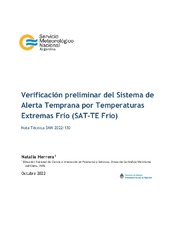Mostrar el registro sencillo del ítem
Verificación preliminar del Sistema de Alerta Temprana por Temperaturas Extremas Frío (SAT-TE Frío)
| dc.contributor.author | Herrera, Natalia | |
| dc.date.accessioned | 2022-10-26T15:15:29Z | |
| dc.date.available | 2022-10-26T15:15:29Z | |
| dc.date.issued | 2022-10 | |
| dc.identifier.citation | Herrera, N., 2022: Verificación preliminar del Sistema de Alerta Temprana por Temperaturas Extremas Frío (SAT-TE Frío). Nota Técnica SMN 2022-130. | es |
| dc.identifier.uri | http://hdl.handle.net/20.500.12160/2167 | |
| dc.description | Fil: Herrera, Natalia. Servicio Meteorológico Nacional. Dirección Nacional de Ciencia e Innovación en Productos y Servicios. Dirección Central de Monitoreo del Clima; Argentina. | es |
| dc.description.abstract | Se presentan los resultados preliminares de la verificación de los alertas emitidos por el Sistema de Alerta Temprana por Temperaturas Extremas Frío (SAT-TE Frío) desde el 9 de junio al 20 de septiembre de 2021, período en el que funcionó de manera interna. El SAT-TE Frío funciona de manera automatizada para 71 estaciones meteorológicas, distribuidas en todo el territorio continental argentino, incluyendo las Islas Malvinas. Emite un alerta diario que puede tener 4 niveles (verde, amarillo, naranja y rojo). Las condiciones necesarias para que se activen los niveles de alerta amarillo, naranja y rojo, están relacionadas con la ocurrencia de un día frío (DF) (alerta amarillo), de una ola de frío (OF) (alerta naranja), o de una OF extrema, tanto en valores de temperatura como en duración (alerta rojo). El alerta verde ocurre cuando no hay ni observaciones ni pronóstico de un DF. En esta Nota Técnica se hará una verificación de los alertas publicados por el SAT-TE Frío a través de los índices de verificación más utilizados a nivel internacional: BIAS, Proporción correcta (PC ~ Accuracy), Probabilidad de detección (POD), False Alarm ratio (FAR), Threat Score (TS) y Equitable Threat Score (ETS), y de un Diagrama de performance, que reúne la información de los siguientes 4 índices: POD, SR (1-FAR), BIAS y TS). | es |
| dc.description.abstract | The alerts issued by the Early Warning System for Extreme Cold Temperatures (SAT-TE Frío in spanish) from June 9 to September 20, 2021, in which it worked internally, are verified. SAT-TE Frío works in an automated way for 71 meteorological stations, distributed throughout the Argentine continental territory, including the Malvinas Islands. The System issue a daily alert that can have 4 levels (green, yellow, orange and red). The conditions necessary for the yellow, orange and red alert levels to be activated are related to the forecast of a cold day (CD) (yellow alert), a cold wave (CW) (orange alert), or an extreme CW (red alert), both in temperature values and in duration. The green alert occurs when there are neither observations nor forecasts of a CD. In this Technical Note, a verification of the alerts issued by the SAT-TE Frío will be carried out through the most widely used verification indices at the international level: BIAS, Proportion Correct (PC ~ Accuracy), Probability of Detection (POD), False Alarm Ratio (FAR), Threat Score (TS) y Equitable Threat Score (ETS), and a Performance Diagram, which gathers the information of four of these indices: POD, SR (1-FAR), BIAS and TS. | en |
| dc.format | application/pdf | |
| dc.language.iso | spa | es |
| dc.publisher | Servicio Meteorológico Nacional. Dirección Nacional de Ciencia e Innovación en Productos y Servicios. Dirección Central de Monitoreo del Clima. | es |
| dc.rights | info:eu-repo/semantics/openAccess | es |
| dc.rights | http://creativecommons.org/licenses/by/2.5/ar/ | |
| dc.subject | VERIFICACIÓN | es |
| dc.subject | SAT-TE Frío | es |
| dc.subject | ARGENTINA | es |
| dc.title | Verificación preliminar del Sistema de Alerta Temprana por Temperaturas Extremas Frío (SAT-TE Frío) | es |
| dc.type | Informe técnico | es |
Ficheros en el ítem
Este ítem aparece en la(s) siguiente(s) colección(ones)
-
Notas técnicas [205]
